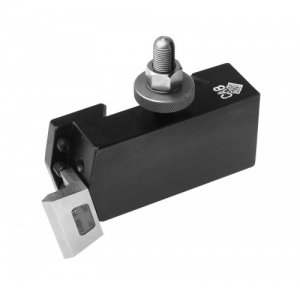Threading away from the chuck using the compound you'd want the compound at the 7:00 position rather than the 5:00 position (I'm not mentioning degrees as the markings vary on lathes but you get the idea). Doesn't matter if you are cutting a LH thread or spindle in reverse with the cutter upside down to cut a RH thread.
As for AG60 or G60, as you know both will cover 8 TPI. Choice really matters on how close to a shoulder you are threading to or how wide the thread relief is. G60 has a wider tip so it's more stout, in theory stronger, better for heavier DOC. If your thread relief is narrow or you are threading closer to a shoulder the AG60 would be the btter choice. Another factor is how usefull the insert will be. AG60 covers a wider range of threads. You have a 12x lathe, it's not likely you'll be taking heavy cuts. IMO the AG60 would be the better choice as it would be more useful for other thread pitches.
Which leads to another thing. I mentioned threading close to a shoulder or to a thread relief. If your threading away from the chuck, obviously you're not threading to a shoulder or into a thread relief so this doesn't matter right? And one of the advantages of threading away from the chuck is you can thread at a faster speed.
Yes but if your thread starts close to a should or your thread relief is narrow, this is where you are starting, you'll have a much smaller margin for error when engaging the half nuts. At 8 TPI the thread dial is already spinner faster than a finer thread. Then add the thought of wanting to thread at a high RPM. If your thread is starting close to a shoulder or in a small thread relief, better engage the half nuts with precision. Make a mistake & chances are you'll destroy your threads.
I thread close to a shoulder or into a very narrow thread relief often cause the stuff I make is small. Sometimes I don't make a thread relief at all. When threading conventionally (into the chuck) you don't have to worry about making a mistake when engaging the half nut. This is why I prefer to thread conventionally & not away from the chuck. It's much easier for me to disegage the half nuts at a mark than trying to catch the thread dial spot on when starting close to a shoulder or in a narrow thread relief if the thread dial is spinning at 10K rpm.
But if you're not starting close to a shoulder or in a narrow thread relief, then ya got nothing to worry about.

My post is already long but I wanted to add anyway since the subject of cutter upside down came up. As said I always single point external threads with the compound feeding towards the chuck, that's how I was taught & is what I'm used to. But when I single point internal threads, I mount my cutter upside down the the spindle in reverse but it's not threading away from the chuck nor is it a LH thread. I'm still using a RH cutter & I'm threading on the backside of the internal bore. Allows me to actually see what I'm threading easier & I don't have to reposition my compound, it stays the same as for external threads.



